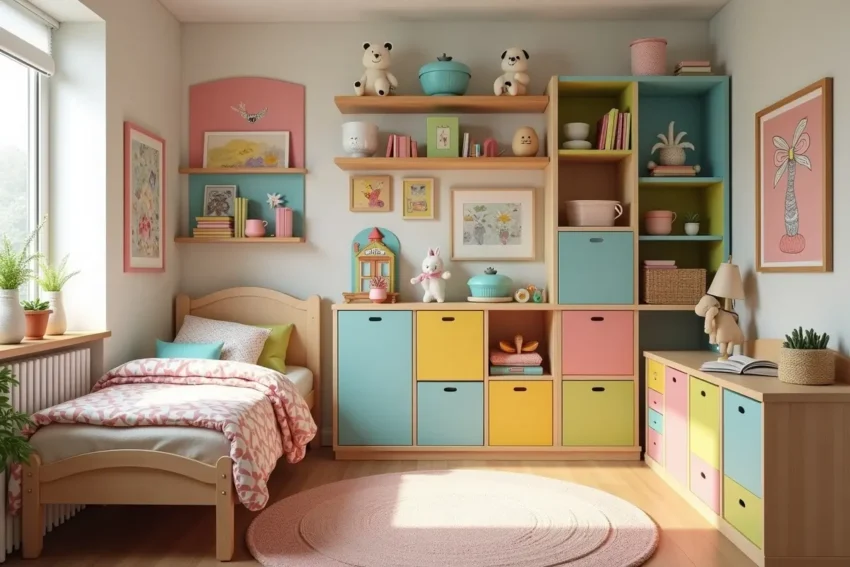Smart Storage Solutions for Kids’ Bedrooms: Combining Function With Fun

Parents everywhere know the daily struggle of keeping a child’s bedroom tidy. Between toys, clothes, books, and art supplies, clutter seems to multiply overnight. Yet a thoughtfully designed space can make all the difference. Smart storage not only helps maintain order but also encourages independence and creativity.
When function meets fun, a child’s bedroom can become both a comforting retreat and an inspiring environment that grows with them. With a few intentional choices, parents can transform the daily cleanup battle into a seamless part of family life.
Contents
Understanding Kids’ Needs
A child’s bedroom is more than a place to sleep. It’s a miniature world where they imagine, play, read, and learn. As they grow, their space must adapt to new interests and habits. From building forts to showcasing a prized collection of Spider-Man toys, every item tells a story about who they are and what they love.
That’s why good design begins with understanding a child’s rhythms and routines. Storage solutions should make it easy for them to find what they need and put things back again, encouraging responsibility and confidence. Low shelves, soft bins, and open compartments work well for younger kids, while adjustable shelving and modular furniture keep older children’s rooms flexible.
When spaces are organized intuitively, kids feel a sense of ownership and pride that helps them care for their belongings. A well-planned room also supports emotional well-being, giving children a calm and comfortable space where their creativity can flourish.
Built-In Brilliance: Making the Most of Small Spaces
Even the smallest bedroom can feel spacious with well-planned built-ins. These custom solutions maximize every inch while keeping floors clear for play. A window seat with drawers beneath, a bed with storage steps, or wall-to-wall shelving can transform an ordinary room into a design-forward haven.
Vertical storage is especially useful in tight spaces, drawing the eye upward and leaving room to move around freely. Built-ins also make it easier to maintain a clean aesthetic, since everything has its place and visual clutter is minimized.
Parents can personalize these structures with pops of color or fun hardware to give them personality without sacrificing function. The best designs anticipate change, using adjustable shelves or removable dividers so the space can evolve as a child grows.
It’s not about packing in more furniture but about using space wisely and blending practicality with visual harmony. A well-executed built-in system feels both timeless and tailored, offering the kind of versatility every family needs.
Multi-Functional Furniture Magic
When every piece of furniture earns its keep, clutter has little chance to settle in. A loft bed with a desk underneath, a bench that doubles as a toy chest, or a dresser that later becomes a study nook can all adapt to shifting needs.
These versatile pieces are perfect for growing families who want to invest once and rearrange later as kids move from playtime to homework sessions. Materials matter too. Durable woods, rounded corners, and easy-to-clean finishes strike the right balance between safety and style. Parents can choose neutral bases and let textiles or artwork introduce bursts of color.
Multi-functional furniture not only simplifies organization but also teaches children how design can be both beautiful and useful. It turns tidying up from a chore into a natural part of daily life. By giving kids spaces that evolve with them, parents can help cultivate independence while keeping the room aesthetically cohesive.
Encouraging Kids to Stay Organized
A storage system is only effective if children actually use it. Making organization playful can help it stick. Clear bins or open shelves invite participation, while color-coded baskets can guide younger kids without needing written labels.
When storage is intuitive, children quickly learn where things go and can take pride in maintaining order. Rotating toys occasionally keeps their interest fresh, ensuring that what’s on display reflects current favorites while older items stay tucked away until they’re ready to reappear.
A small shelf for personal treasures or art projects gives them a sense of control over their environment. Parents often find that when the setup feels easy and inviting, tidying up becomes a shared routine rather than a daily struggle. Adding simple rituals—like a five-minute evening cleanup together—can reinforce good habits and make organization a natural part of family life.
Design That Grows With Them
Kids’ needs evolve faster than their rooms often do, which is why flexibility is key. Future-proofing design choices saves both effort and expense. Choosing a neutral base for walls and large furniture allows accessories, bedding, and art to change over time without requiring a full redesign.
Modular systems can adapt from nursery to teen years, shifting from toy bins to book storage with minimal effort. Investing in quality materials ensures the room remains stylish and sturdy through every stage. The key is to strike a balance between timeless structure and flexible details.
Parents might start with low shelving that later transitions into a study station or convert a play corner into a cozy reading nook. Designing with longevity in mind not only conserves resources but also helps children feel a sense of continuity as their tastes and needs evolve. The result is a bedroom that grows gracefully alongside them.
Conclusion
When parents view storage as part of the design rather than an afterthought, a child’s room transforms into a space that supports growth, creativity, and calm. The goal isn’t perfection but practicality with personality—a room that feels lived in yet loved. By blending smart organization with thoughtful design, families can create bedrooms that look beautiful, function effortlessly, and evolve gracefully as their children do.



